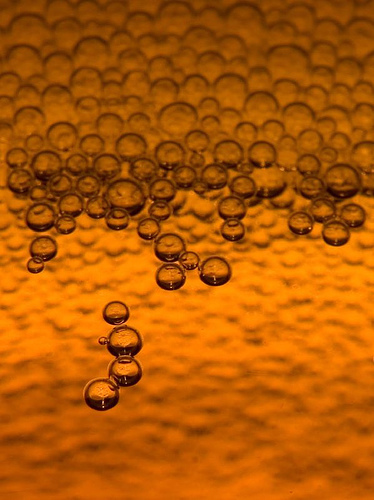A Head Above

Each of the ingredients of beer makes an obvious contribution to the finished product, be it ale, lager, porter, stout or any other type of beer. Interestingly, the smaller the proportion of each ingredient, the more difference it makes. Beer is mainly water and while the mineral content of the water can make more or less suited to extracting sugar from malt, the particular source does not make much difference to the flavor of the beer.
The type of malt (or types of malt) determines the body or "mouth feel" of the beer, its color and the basic flavor. One reason why most big brand beers (I won't name names, but you know who I mean) have so little flavor is that the malt is supplemented by other grains (corn or rice) that contribute more sugar at a lower price than barley but which contribute no flavor at all.
Hops, the dried resinous flowers (or strobiles) of a climbing vine called humulus lupulus contribute much of the aroma and bitterness to beer. At one time, beer was flavored with a host of ingredients from hops to orange peel, cloves and coriander seeds but eventually hops became the sole addition except in Belgium where many ancient traditions are kept alive in their myriad styles of beer. If someone says that he or she doesn't like beer, it is usually the flavor and aroma of hops that they object to.
Finally, the yeast determines the alcohol content and the way in which the beer must be made. Some yeasts form a think layer of foam on top of the beer as it ferments. This "top fermenting" yeasts ferment at relatively warm temperatures and result in beers with complex secondary aromas that can suggest fruit or flowers, the ale family. Other strains of yeast work at colder temperatures and do not collect on top of the beer. These "bottom fermenting" yeasts are responsible for the lager family, characterized by pure, clean aromas of hops, malt and very little else.
So where does the head come from and why do some beers have more foam than others? The head on a glass of beer, like the foam in soda and the bubbles in Champagne, results from carbon dioxide (a product of fermentation) that has been dissolved in the beer, escaping when released from the pressure of the bottles, can or keg. Some beers are naturally foamy and others are artificially carbonated (essentially turned into soda) when they are bottled. The nature of the head depends less on the amount of carbon dioxide than on the nature of the liquid it is escaping from.  For example, there is far more gas in a bottle of Champagne, and it is under far more pressure, than in a comparable amount of beer, but after the initial pop, the foam on a glass of Champagne disappears in a matter of seconds, whereas the head on a glass of beer can last considerable time. This is because in addition to extracting sugar from the malted barley, the mashing process also extracts proteins that bond together to form an invisible web that traps the gas as it tries to escape, resulting in longer lasting bubbles. Some grains contribute more of these than others. The addition of a small amount of malted wheat can result in a much more foamy product than one can get from barley alone because wheat contains a large amount of gluten. Gluten is a resilient and elastic protein that holds carbon dioxide bubbles better than any other. Not surprisingly then, the foamiest of all beers are wheat beers that must be very carefully poured if one doesn't want to end up with a glass of nothing by foam. Don't even consider drinking a Heffeweizen from the bottle.
For example, there is far more gas in a bottle of Champagne, and it is under far more pressure, than in a comparable amount of beer, but after the initial pop, the foam on a glass of Champagne disappears in a matter of seconds, whereas the head on a glass of beer can last considerable time. This is because in addition to extracting sugar from the malted barley, the mashing process also extracts proteins that bond together to form an invisible web that traps the gas as it tries to escape, resulting in longer lasting bubbles. Some grains contribute more of these than others. The addition of a small amount of malted wheat can result in a much more foamy product than one can get from barley alone because wheat contains a large amount of gluten. Gluten is a resilient and elastic protein that holds carbon dioxide bubbles better than any other. Not surprisingly then, the foamiest of all beers are wheat beers that must be very carefully poured if one doesn't want to end up with a glass of nothing by foam. Don't even consider drinking a Heffeweizen from the bottle.
Essentially the head on a glass of beer is not very different from bread dough (although far thinner and more delicate) and what you see happening on top of your glass is very similar to what happens when the bread dough rises: Next time you make bread (yes, Josh and Brent make their own bread), notice the strong aroma of alcohol when you punch down the dough. And all of this raises the chicken-or-the–egg question of whether brewing beer was originally a byproduct of bread baking or vice versa.
It's an ongoing debate over which is the bigger vice.
Read more about our celebration of the brew. Click here.



